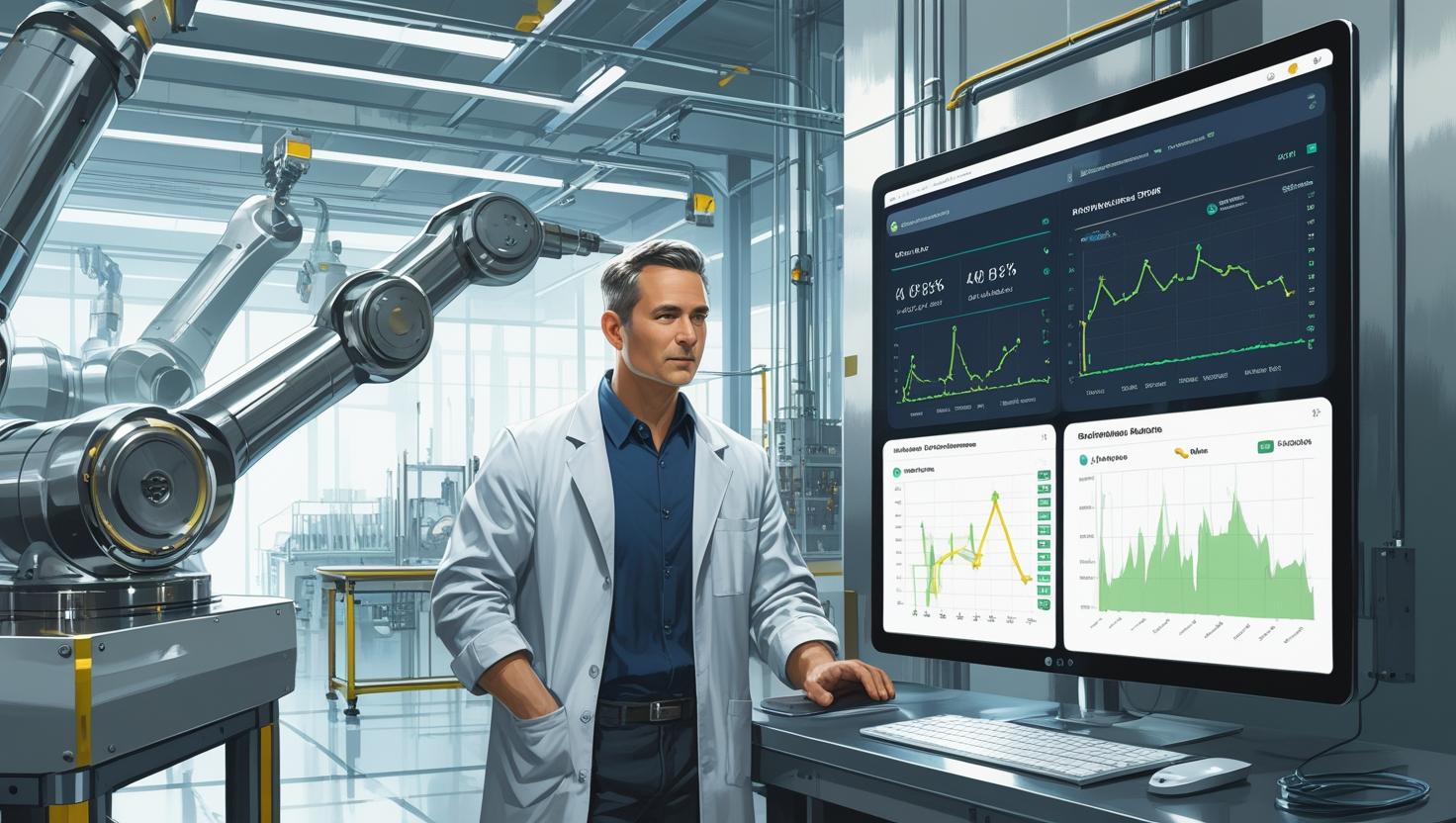Predictive Maintenance MVP with AI and IoT

Introduction
Industries worldwide are facing increasing pressure to reduce downtime, optimize resource usage, and extend the lifespan of machines. Traditional maintenance models such as reactive or scheduled maintenance are no longer efficient for the digital age. Predictive maintenance powered by artificial intelligence and the Internet of Things is emerging as a revolutionary solution to address these inefficiencies. A minimum viable product or MVP built with AI and IoT can deliver real time equipment insights with limited development resources and faster deployment. This case study explores the potential and implementation strategy of a predictive maintenance MVP across industries like manufacturing, transportation, energy, and construction.
Understanding What It Is and How It Works
Predictive maintenance is a data driven maintenance strategy that uses sensor data and machine learning algorithms to predict when a piece of equipment is likely to fail. The MVP model focuses on building a lightweight version of the complete system that monitors critical machines and alerts the maintenance team only when anomalies are detected.
Here is how it works
-
IoT sensors are attached to motors pumps, HVAC systems or production machinery to capture real time data like vibration temperature noise and pressure.
-
This data is sent to a cloud or edge computing system where AI models analyze patterns and detect anomalies.
-
Based on historical failure patterns the AI predicts potential breakdowns and sends alerts for timely action.
-
Dashboards display equipment health metrics failure probabilities and recommended maintenance tasks.
The MVP can focus on one plant or a few machines and scale up later. This helps companies validate the effectiveness of AI IoT based predictive systems before full rollout.
Challenges in Building a Predictive Maintenance MVP
-
Sensor Integration and Data Quality
Not all machines are sensor ready. Retrofitting legacy equipment with IoT devices can be technically complex. Inaccurate or insufficient data can affect AI model training and outcomes. -
Initial Training Data Requirements
AI models need large sets of historical failure and performance data. For newer machines or less monitored processes collecting adequate labeled data is challenging at the MVP stage. -
Real Time Processing and Latency Issues
An effective system must offer near real time alerts. Building a lightweight system that handles high frequency sensor data without lag is difficult without a robust backend. -
Scalability Constraints
Designing an MVP that performs well on a small scale but is also scalable in architecture for future phases requires careful planning of the tech stack and model design. -
User Adoption and Trust
Maintenance teams might distrust AI recommendations initially especially if the system is new and lacks transparency. Training and change management become key hurdles. -
Security of Industrial Data
Transmitting real time machine data across networks opens up security concerns. The MVP must incorporate authentication and encryption even at its basic level.
Solutions
To overcome the challenges faced during the MVP stage, targeted and pragmatic solutions are required. These solutions are crafted to ensure that even at the minimum viable level, the predictive maintenance system is accurate, actionable, and scalable.
-
Smart Sensor Integration for Legacy Equipment
For machines that do not have built-in sensors, affordable retrofit sensor kits are used. These can include vibration sensors, thermocouples, and acoustic monitors. Bluetooth or LoRa based wireless modules are used to reduce wiring needs and increase deployment speed. -
Use of Simulated and Hybrid Data Sets for Model Training
In scenarios where historical failure data is not available, simulated failure scenarios and manufacturer specifications are used to train early machine learning models. Once the system is in use, live data is continuously added to improve predictions. -
Edge Computing for Real Time Performance
To reduce latency, edge gateways are deployed close to the machines. These gateways process sensor data locally using lightweight AI models and only transmit relevant insights to the cloud, ensuring real time alerting and bandwidth savings. -
Explainable AI Models for Trust and Adoption
The MVP uses transparent machine learning algorithms such as decision trees or random forests that allow maintenance staff to understand the reason behind each prediction. This builds trust and increases user adoption. -
Security Measures from the Start
Even at MVP level, device authentication and encrypted data transmission are implemented. Basic compliance measures such as audit logging and role based access are included to meet industry standards. -
Dashboard and Mobile Alerts for Instant Visibility
The MVP includes a user-friendly dashboard that shows equipment status and sends alerts through SMS email or app notifications. Maintenance teams can act on these alerts without needing to be in front of a screen.
Technology Stack
A predictive maintenance MVP requires a modern yet lightweight technology stack that balances real time processing, scalability, and user experience.
-
IoT Hardware and Connectivity
-
Sensors: Vibration sensors, temperature sensors, acoustic sensors
-
Microcontrollers: Arduino, ESP32, Raspberry Pi for local data collection
-
Gateways: NVIDIA Jetson Nano or Intel NUC for edge processing
-
Connectivity: LoRaWAN, MQTT, Bluetooth Low Energy, WiFi
-
Data Processing and Storage
-
Edge Processing: Node-RED or TensorFlow Lite for local AI inference
-
Cloud Platforms: AWS IoT Core, Azure IoT Hub, or Google Cloud IoT
-
Databases: InfluxDB or TimeScaleDB for time series data
-
AI and Machine Learning
-
Model Development: Python with libraries like Scikit-learn, XGBoost
-
Frameworks: TensorFlow, Keras for neural networks
-
Data Annotation: Label Studio or custom internal tools
-
Application and Dashboard Layer
-
Backend: Node.js, Python Flask
-
Frontend: React.js or Angular for dashboards
-
Visualization: Grafana or Plotly Dash for real time graphs
-
Notification and Alerting Systems
-
Services: Twilio for SMS alerts, Firebase for push notifications
-
Monitoring: Prometheus and Grafana for system health monitoring
-
Security and Compliance
-
Authentication: OAuth 2.0 or JWT tokens for secure access
-
Encryption: TLS for data in transit, AES for local data encryption
Implementation Phases
A structured and phased implementation ensures the MVP meets objectives while staying lean. The following five phases describe the step-by-step rollout of the predictive maintenance MVP.
-
Phase One: Requirement Discovery and Machine Assessment
The MVP journey begins with identifying critical machines prone to unexpected breakdowns. Their physical conditions, past maintenance logs, and failure modes are documented. Stakeholder interviews with plant engineers and technicians define the MVP scope and KPIs. -
Phase Two: Sensor Setup and Data Pipeline Configuration
In this phase, IoT sensors are installed on target machines, and edge devices are configured to collect and stream data. Data preprocessing scripts are written to clean, normalize, and tag the data for training. Connectivity protocols such as MQTT or LoRa are established for real time data transmission. -
Phase Three: AI Model Development and Testing
Using the initial dataset, AI models are trained to detect signs of degradation or failure. These models are deployed first on edge gateways and then tested using live sensor input. If a model detects high vibration levels or unusual temperature spikes, it triggers alerts. Continuous feedback loops are established for model refinement. -
Phase Four: Application and Dashboard Development
This phase includes the creation of a lightweight web-based dashboard for maintenance teams to view machine statuses, anomaly reports, and upcoming maintenance needs. Alert mechanisms are integrated into the platform, and role-based access is configured. The UI is optimized for plant floor usage on tablets and smartphones. -
Phase Five: Pilot Testing and Feedback Integration
A small group of users from maintenance and operations teams begin using the MVP in a real environment. User feedback is gathered to improve alert clarity, dashboard usability, and data accuracy. Security protocols are stress tested, and final tuning is done before planning scale up.
Impact
The implementation of predictive maintenance MVPs has brought measurable improvements across multiple dimensions of industrial operations. One of the most significant impacts has been the reduction in unplanned downtime. By continuously monitoring machine health through AI-driven analysis of IoT sensor data, businesses have reported up to a 40 percent decrease in breakdown-related stoppages. This translates directly into increased production time and more predictable workflows.
Another key impact is the optimization of maintenance schedules. Instead of following rigid calendar-based maintenance cycles, teams can now intervene only when needed, which has reduced maintenance costs by up to 25 percent in many early implementations. This precision also lowers the risk of over-maintenance, which can lead to unnecessary part replacements and labor costs.
Asset longevity has improved significantly. Machines are better cared for with data-backed decisions, leading to fewer emergency repairs and a longer lifecycle. This extends the return on investment for industrial equipment and defers capital expenditure.
The predictive maintenance MVP has also impacted workforce productivity. Maintenance teams are no longer overwhelmed with constant checks and emergency fixes. Instead, they are empowered with actionable insights, enabling them to work smarter and with better focus. This shift has improved job satisfaction and has reduced safety incidents on the factory floor by minimizing sudden failures.
From a strategic perspective, businesses leveraging this MVP approach are gaining a competitive edge through operational efficiency and smart resource allocation. The predictive insights generated also feed into broader analytics frameworks, helping with supply chain planning, warranty optimization, and customer support readiness.
The early results of these MVPs are encouraging decision makers to move toward full-scale implementation, making predictive maintenance not just a technical advantage, but a business imperative for sustainable and data-led growth.
Conclusion
The predictive maintenance MVP powered by artificial intelligence and internet of things has proven to be a transformative solution for modern industry. By shifting from reactive to proactive equipment management, businesses can ensure higher uptime, lower maintenance costs, and better asset performance. The MVP stage plays a vital role by allowing companies to test the effectiveness of predictive algorithms and IoT sensor integration on a small scale before scaling across all operations. As manufacturing and industrial ecosystems grow more digital and connected, predictive maintenance will not just be a competitive edge but a fundamental requirement for resilience and efficiency. Organizations that embrace this shift early with a well structured MVP strategy will lead the way in smart operations, data driven decisions, and sustainable growth.
Frequently Asked Questions
What is predictive maintenance and how does it differ from preventive maintenance
Predictive maintenance uses AI and IoT to monitor real time equipment data and predict failures before they occur. Unlike preventive maintenance which follows a fixed schedule, predictive systems only trigger maintenance when actual data shows signs of wear or risk.
Why is an MVP approach important for predictive maintenance
An MVP helps companies test predictive capabilities on a smaller scale using selected machines and basic dashboards. It reduces risks and allows teams to gather insights before investing in a full scale solution.
What industries benefit most from predictive maintenance MVP
Industries with heavy machinery like manufacturing, oil and gas, automotive, and logistics gain the most value. It also applies well in data centers and smart building operations where uptime is critical.
How long does it take to implement a predictive maintenance MVP
The MVP stage can take between six to twelve weeks depending on the complexity of assets and availability of data. This includes sensor integration, data modeling, and deployment of dashboards.
What data is needed for predictive maintenance to work
The system relies on data such as vibration, temperature, pressure, usage hours, and historical failure logs. These inputs feed the machine learning models to detect anomalies and forecast failure patterns.
Is predictive maintenance cost effective for small businesses
Yes, especially when approached through an MVP. Cloud based platforms and affordable IoT sensors make it possible for small manufacturers and asset intensive businesses to adopt predictive tools without large upfront costs.








